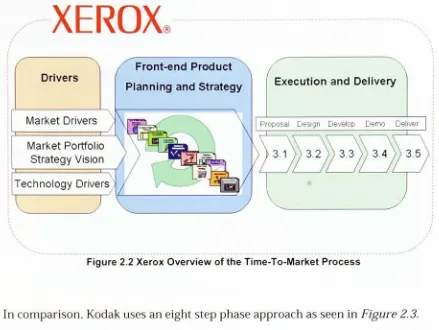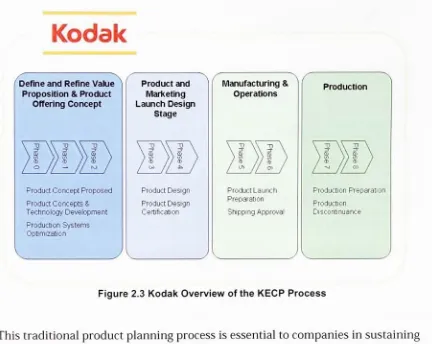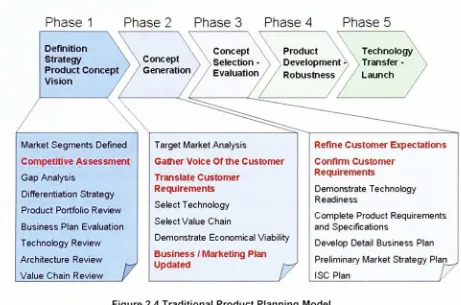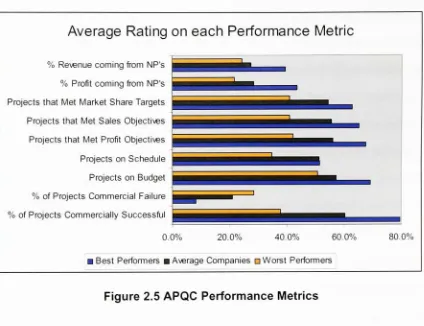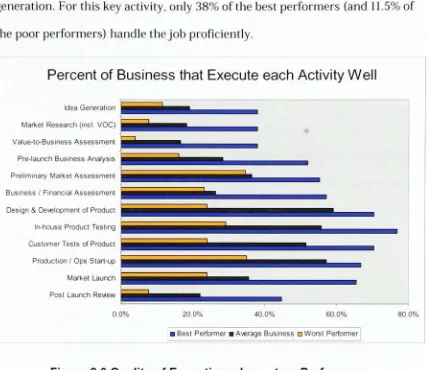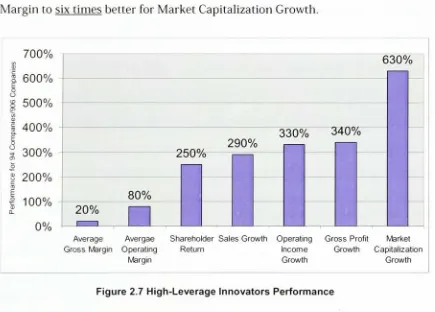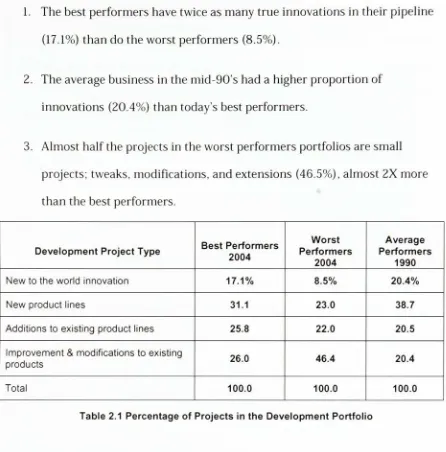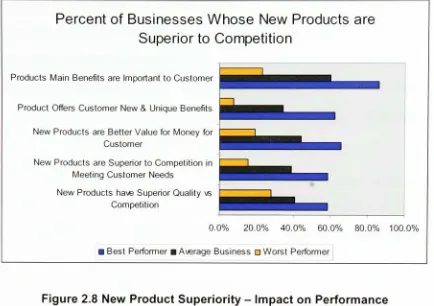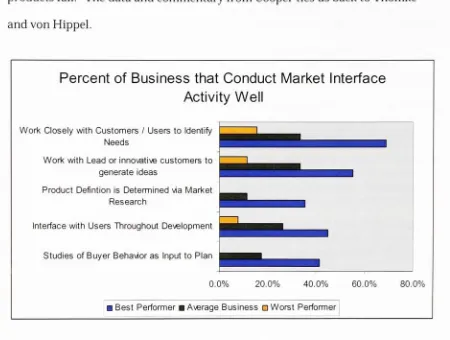Rochester Institute of Technology
RIT Scholar Works
Theses
Thesis/Dissertation Collections
1-1-2007
Immersion & iteration: Leading edge approaches
for early stage product planning
Christopher Bondy
Jack Rahill
Michael L. Povio
Follow this and additional works at:
http://scholarworks.rit.edu/theses
This Master's Project is brought to you for free and open access by the Thesis/Dissertation Collections at RIT Scholar Works. It has been accepted for inclusion in Theses by an authorized administrator of RIT Scholar Works. For more information, please contactritscholarworks@rit.edu.
Recommended Citation
Immersion
&
Iteration:
Leading
Edge Approaches for
Early
Stage
Product
Planning
"Delivering
Breakthrough
Products"Christopher
Bondy
Jack Rahill Michael L. PovioAcademic Advisor:
Robert Boehner
-Rochester Institute of Technology, College of Business
Industry
Advisors:Tony
Federico - XeroxCorporation, Corporate Officer Business
Group
Fred DeBolt
-Xerox Corporation, VP Color Line of Business
Rochester
Institute
ofTechnology
Master of Science in Product Development
Capstone Research Project
November 14, 2007
Illllllersion
& Iteration: Leading
Edge Approaches for Early Stage
Product Planning
Delivering Breakthrough Products
Signatures
Aca
d
e
mi
c A
dvi
so
r
:
Robert Boehner
Robert Boehner
Rochester Institute of Technology, College of Business
In
d
u
s
try
A
dvi
so
r
s:
Tony Federico
Tony Federico
Xerox Corporation, Corporate Officer, Business Group
Fred DeBolt
Fred DeBolt
Xerox Corporation, VP, Color Line of Business
MPD Dir
e
ct
o
r:
Mark Smith
Mark Smith
Immersion & Iteration: LeadingEdgeApproachesforEarlyStageProductPlanning (DeliveringBreakthrough Products)
Acknowledgments
Theresearchpaperbeforeyouisthefinalprojectforatwoyear endeavorinthe
pursuit of a MasterofScienceforProduct Developmentat Rochester Instituteof
Technology. Ithas been a six monthinvestmentthathas requiredthehardwork
of
balancing
family,
work and academics. Theexistenceofthis paperisdueto thesupport ofmanypeople which we wouldlike tosincerelythank.
OurFamilies: Whohave endearedthe 2years with us and wethank them for
theirunderstanding and support. Jackwouldliketoespeciallythankhiswife Gail
andtwo
daughters,
MeghanandEmmafor enduringthelong
nights andtimeawayfrom one another. Mikethankshiswife
Tracey
andkidsJacob, RyanandLindsey
fortheirmoral support. Chriswouldliketoexpresshisthanks to hiswifeGlenda and4teenagers; Kaelyn, Jacob, MariahandLucasforunderstandingthe
sacrifice andacknowledgingthevalue ofthis program.
Our Advisors: Dr. Robert Boehnerforguidingusthrough this seemingly
endless research paper. Theencouragement and motivation you gave us makes
thiseffort worthwhile. "Fromcloudsofideastogranite, prettyimpressive."
Our Companies: Xerox andDMHforgivingusthis opportunitytobetter
ourselvesineffortstogrow withthecompany.
Our Colleagues: the camaraderie oftheclass madethiscourse most enjoyable.
The
friendship
andbondsmadeherewilldefinitely
last alifetime.MPD
Faculty
andStaff: MarkSmith, Chris Fisherand all theprofessors.Youhave donean excellentjobin providingthe students ofthis course withthebest
opportunityfor learning.
Theroots ofeducation are
bitter,
butthefruitissweet. -AristotleThesis/Dissertation Author Permission Statement
Name of author:
..::To
~/J
,~;£
'/
j
v;i//
'
s
$djh
,.II
1;,e
~
h//,!./ Degree:M
S
Program:
8-dad
p,£3t/~~t?hnr&1_./r--: College: 6 N f.-,; /l/?-t?-.4)d/b
'
I understand that I must submit a print copy of my thesis or dissertation to the RIT Archives, per current RIT guidelines for the completion of my degree. I hereby grant to the Rochester institute of Technology and its agents the non-exclusive license to archive and make accessible my thesis or dissertation in whole or in part in all forms of media in perpetuity. I retain all other ownership rights to the copyright of the thesis or dissertation. I also retain the right to use in future works (such as anicles or books) all or part of this thesis or dissertation.
Print Reproduction Permission Granted:
I,
P
;)
/l-;7?q--
/,.
/'
/
,
hereby grant permission to the Rochester institute Technology to reproduce my print thesis or dissertation in whole or in pan. Any reproduction will not be for commercial use or profit.John Rahill
Signature of Author: _ __ _ _ _ _ _ _ _ _ _ _ _ _ _ _ _ Date:
Print Reproduction Permission Denied:
I. , hereby deny permission to the RlT Library of the Rochester Institute of Technology to reproduce my print thesis or dissertation in whole or in part.
Signature of Author: _ _ _ __ _ __ _ _ _ _ _ _ _ _ _ _ Date: _ _ __ _ _
Inclusion in the RIT Digital Media Library Electronic Thesis & Dissertation (ETD) Archive
I,
::z-;
~/
7 -~
/l (
'
/ /
,additionally grant to the Rochester Institute of Technology Digital Media Library (RIT DML) the non-exclusive license to archive and provide electronic access to my thesis or dissertation in whole or in pan in all forms of media in perpetuity.I understand that my work. in addition to its bibliographic record and abstract. will be available to the world-wide community of scholars and researchers through the RIT DML. I retain all other ownership rights to the copyright of the thesis or dissertation. I also retain the right to use in future works (such as articles or books) all or part of this thesis or dissertation. [am aware that the Rochester Institute of Technology does not require registration of copyright for ETDs.
I hereby certify that. if appropriate. I have obtained and attached written permission statements from the owners of each third party copyrighted matter to be included in my thesis or dissertation. I certify that the version I submitted is the same as that approved by my committee.
b3,~p'&-Immersion 8 Iteration l eadii
Executive
Summary
Developing
anddelivering
products thattruly
delight customers issurprisinglymore of a unique occurrencethan most wouldbelieve. Amongst the vastarray of
mediocre products reside afew eliteproductsthat customers
truly
seek outtoacquire beyond anythingelse offered in the marketplacethese productsare
truly
"breakthrough"
products. Breakthrough inthat theyprovide customer
benefitsthat addressthe unmet and unspokenwants and needs ofthe customer.
Breakthroughproductsdelivervalue inamannerthatexcites the customer
by
thealmost intuitivewaythese products resonate withtheirreal world requirements.
From the
developers'
perspective, breakthrough products definemarkets, steal
market share and deliver better profit marginsthan incremental productsthat
only providesustaining business results.
Uncovering
thespecific requirementsthat drive breakthroughproducts is adaunting
product planningtask intoday'sfast moving, competitive, andhigh-techglobal marketplace. Both B2C and B2Bproduct development organizations
aretaskedwithuncoveringcustomer requirementsthatwill catapulttheir firms
ahead ofthepack in a privileged position asthe marketleader.
History
suggestshowever that the path tobreakthroughproductsislesstraveled and reservedfor
onlyafew companiesthat havea uniqueway of
delivering
repeat successes.Why
is it that the traditionalproduct planning processeshave notbeen successful at
Immersion& Iteration: LeadingEdgeApproaches forEarlyStage ProductPlanning
researchproject; thorough investigationofthe obstaclesinthetraditional
product planningprocessthat hamperthe conceptualization anddevelopmentof
breakthroughproducts willbediscussed.
Thetraditionalproduct planning processisa complex process of stages and gates
thatis oftenhandicapped
by
a varieddegree ofcommitment,understandingandparticipationfromcross-functional teams thatdon'talways perceive the valueof
allthe hurdlesand processes. Therearemanycompanies who excelinthe
regimented processes ofthevariousstages and gates involved inthe traditional
productplanningprocess. Thesecompanies have successfully delivered
incrementalproducts thatmeet customer needs. These companieshave a solid
business plan with asteadycustomerbase thatdelivers sustaining business
results.
Following
the traditionalproduct planningand developmentprocess withprecisionusually delivers steady businessgrowth at or slightly above
industry
growth rates.
This researchproject showsthat a solid execution ofthe traditional process can
onlyyieldwhatis referredtoas
"incremental"
product developmentat best. For
manycompanies, product development disconnectsare as fundamentalas their
inability
toconsistently followa process. Yettheproblemwithdelivering
breakthroughproducts goesbeyondthe traditionalplanningprocess. Theremust
be something more.
Why
is it that themarket leadersseemto consistentlydeliverbreakthroughproducts? Arethesemarketleaders
doing
something differentthatImm
Theansweris thatbreakthrough products require adifferent product planning
approachthan the traditionalproductplanningprocess whichis somewhat serial
in nature. Thetraditional productplanningprocess isstructured tobe more of
one-time-throughtheprocess approach,or
"pipeline"
thathas limited
commitment toiteration prototyping andusually muchtoo limited engagement
withthe target customer. Multiplestudies haveshown thatfirms are ineffective
atcapturingand
interpreting
VOC andreflectingtrue customer needsin theirnew products.
The author's conductedprimaryresearch with several north eastern companies
as well asbenchmarked several companiesthroughsecondary researchin efforts
touncover the process keysto
delivering
breakthrough products. Throughthisresearch effort and referencesfrom
industry
experts such as Cooper, Christensen,vonHippelandUlwick, this project validatedthatcompanies who deliver
breakthroughproducts engage in more elaborate activities
during
theearly stagesoftheproduct planningprocess. These companieshave much moreintimate
immersionwith the targetcustomers, and buildprototypes and iteratemore
frequently
back throughtheplanning processthroughout all stages ofdevelopment.
Companiesthat deliver breakthrough productshavean uncanny wayof
discovering
whatcustomerreallywantand need. The ability that these successfulproductdevelopment companies haveto uncoverneeds, wants and desired
outcomes isgroundedina passion for understanding,
learning
andimmersing
Immersion & Iteration .1ageProduct
Planning :
comprehensiveimmersion, these
leading
edge companies are abletobetterformulatethe total customer experience andinterpretthat experience into
specifications thatdelightthe targetcustomer.
The direct associationbetweenmore comprehensive immersion, prototypes, and
iterationprovidedthe author's withinsights to
develop
a unique productplanningprocess thatistailored specifically for breakthroughproducts. This "new"
product planningprocessfor breakthroughproductsis presented in this
research project as an alternate process approachthatcanoverlaythe traditional
productdevelopment process for productinitiatives thatarefocusedat
breakthroughvs. incrementalefforts.
Both consumerand commercial customers votewiththeirwallets
by
acquiringproducts thatintercept theirspoken and unspokenrequirements most effectively.
Theobject ofthisresearch projectisto betterunderstandthe approaches
followed
by
successful companies who consistently deliverbreakthroughproductsand synthesize thoseapproachesintoa new product planning process
modelthatcanbe better understood andfollowed
by
companieswishing toplan,Table
ofContents
Executive
Summary
vTable ofContents ix
Table ofFigures xi
Table ofTables xi
Chapter 1: Project Overview 1
Introduction 1
Problem Statement 2
ResearchObjective, Scope,
Methodology
2Value Added toKnowledge Base 3
Chapter 2: Background Research 5
Traditional Product
Planning
Process 5Phases andGates ofProduct
Planning
7Industry
Accepted Model 12HI: Traditional Product
Planning
isRarely
Done Well 13 H2: Traditional ProductPlanning
Done WellOnly
Generates IncrementalResults 19
H3: EvenifDoneWell, Traditional Product
Planning
Does Not Have the ProcessCapability
to Deliver BreakthroughProducts 23 Chapter 3:Primary
Research-Assessing
ProductPlanning
Processes 30Introduction 30
Analysis 34
VOC andMarket Input 34
ProductDefinition 36
Product Performance Compared to theCompetition 37
ProofofHI 38
ProofofH2 40
Chapter 4:
Using
Immersion toEnhance theProductPlanning
Process 43
Introduction to Immersion 43
Secondary
Research 44Hill-Rom's Riseas Bed Supplier for Acute Care Hospitals 44
Appleandthe iPhone: 47
Pratt & Whitney: 51
Steelcase: 56
3M- Lead Users 59
OnStar 63
Chapter5: Product
Planning
Approaches to Immersion 70Immersion "Pull" Approaches: 72
EthnographicStudies: 73
Ethnographic Techniques: 74
Interviewsand Surveys: 76
Immei adingEdge ApproachesforEarlyStage Product
Planning
(Deln roducts)
Table
ofContents
Continued
Lead User Engagements: 85
Immersion "Push" Approaches: 86
Virtual Reality: 87
Using
Avatarsforproduct planningpurposes: 89Alpha Labs: 90
Co-evolution: 93
Immersion Approaches Summary: 95
Chapter6: Immersionand Iterationprocess forBreakthrough
Products 97
Tradition Product
Planning
withImmersion; Phase1 a: High-levelStrategy
99Tradition Product
Planning
withImmersion-T3Pi 112
Immersion Delivers Breakthrough Products 112
Barriers in
Adopting
the Immersion Model 115Values, Processes &Resources 116
Culture 118
Lack ofCorporate Commitment 118
Lackof specific "immersionand
iteration"
skills 119
Financial Barriers 120
Time-to-Market Barriers 121
Summary
122Chapter 7: Capstone
Summary
123Chapter 8: Areas for Future Research 125
Appendix 1 : Questionnaire Resultsand Interview Notes 126
Appendix 1.1: Questionnaire 126
Appendix 1.2: InterviewResults 130
Appendix 1.3: Independent
Study
Kodak Results 131 Appendix 1.4: IndependentStudy
Xerox Results 132Appendix 1.5 Interview Notes 133
Appendix 2 Xerox Time to Market
(TTM)
Model 143Appendix 3: Kodak KECP
(1994)
Model 145Appendix 4: Kahn - Production
Planning
Essentials 2001 146Appendix 5: Academia Sources 149
Appendix 5.1: New Product Management
-Crawford & DiBenedetto 149
Appendix 5.2: Effective Innovation
-Don
Clausing
& VictorFey
149References 150
Websites 152
Immersion 8, Iteration I eadin
hrough Pi
Table
ofFigures
Figure 2.1: ModelofProduct
Planning
Pipeline 7Figure 2.2: Xerox Overviewofthe Time To Market Process 10
Figure 2.3: KodakOverview ofthe KECP Process 11
Figure 2.4: Traditional Product
Planning
Model 12Figure 2.5: APQC Performance Metrics 15
Figure 2.6:
Quality
ofExecution-Impact on Performance 16
Figure 2.7: High-Leverage Innovation Performance 18
Figure 2.8: NewProduct
Superiority
-Impacton Performance 22
Figure 2.9: VOC and Market Inputs
-ImpactonPerformance 27
Figure 3.1: VOCand Market Inputs
-Questionnaire Results 35
Figure 3.2: Product Definition- Questionnaire Results
37 Figure 3.3: Product Performance Comparedto the Competition
-Questionnaire
Results 38
Figures 3.4: Pareto ofCompanies Scores 40
Figure 3.5: CAGRvs.
Survey
Score 41Figure 3.6: CAGR vs.
Industry
Growth Rate 42Figure 4.1: Hill-Rom COMLinx Communication System 46
Figure 4.2: AppleiPhone 48
Figure 4.3: Steelcase PolyVision Interactive
Display
58Figure 4.4: 3MSteri-Strips 62
Figure 4.5: OnStar Console 64
Figure 5.1: Immersion Categories 71
Figure6.1: Traditional Product
Planning
Processw/Immersion Front-end 98 Figure 6.2: StrategicPlanning
coupled withImmersion & Iteration 106Figure 6.3: T3Pi Model 112
Table
ofTables
Table 2.1: PercentageofProjects in theDevelopment Portfolio 20
Table 4.1: Pratt&
Whitney
Opportunity
Scores 53Table 4.2: Ideas Generated
by
Pratt &Whitney
Team 54Table5.1: Cordis'
Angioplasty
BalloonOpportunity
Scores 83eakth
achesforEarlyStage ProductPlanning
Chapter
1:
Project Overview
Introduction
Newproductdevelopment isconsideredthe
"lifeblood"
ofanycompany,
driving
increased revenues, marketshare, andbrand recognition. Butnew competition, a
global marketplace, newtechnologiesandrapidly changing customerneedshave
created a marketplacethatmakes itdifficulttosucceed. Yetfirmsthat deliver just
onebreakthroughproduct or service can alter thefuture ofthecompany;
leading
tonewproducts, product familiesor even create a whole newindustry. A
breakthroughproductis definedas a productthatnotonly meets a customer's
unmet wantsand needs butalso delightsthe customerin awaythatcreates an
emotional connection and loyaladoption versusthe competition.
However, tryingtoproducea breakthroughproduct or service isverychallenging.
Benchmarkstudies haveshownthatahigh percentage
(30-40%)
of new productventuresfail. Themajor reasons citedfor failureare marketingor customer
related; thepoorexecution ofthe early stageintheproductplanning process,
lack ofcustomer-based ideasand the
inability
to understandthejob the customerneeds toget done.These tasks are part of atraditional productplanningprocess
thatmanycompanieshave incorporated in theirwork flow. It isthis processthat
presents a numberofproblems forcompaniesthatwishtodeliver breakthrough
[mini Iteration I eadin ining
Problem
Statement
Companies thatuse the traditionalplanning process use a varietyoftechniques
to capture customer wants and needs.These needs arecommonlyreferred toas
"Voiceofthe Customer" orVOC. The VOC produces product conceptsthatare
mapped to functionalrequirements via the
"Quality
Function Deployment"method or QFD. The product development communitythen usesthese
requirements to create a product or servicefor the customer.While this
structured process is clearlyvital forcontinued marketgrowth, it presents three
problems forfirms thatwant to
develop
breakthroughproducts.1. Thetraditional product planningprocess is rarelyexecuted well
2. Thetradition productplanningprocess when executed well oftendelivers
only incremental product improvements at best
3. Even ifdonewell, traditional productplanning does not have the process
capability todeliver breakthrough products
Research
Objective,
Scope,
Methodology
Thisresearch paper will assess the strengths and weaknesses ofthe three
traditional product planning problems stated above comparedto best-practice
industry
examples. Thefocuswill beon the early stages of process wheretheVOC's are
being
collected and interpreted. Theexamples will showthat when thetraditional product planning process isdonecorrectly, the process
typically
yieldstion: I <v geApproaches forEarlyStage ProductPlanning
existingproduct, notnecessarilya productthat isbreakthroughor onethat
ultimately delightsthe customer.
In orderto substantiatethese problems, several companiesaffiliated with the
MPDprogram will beinterviewed tounderstandtheirearlyphases ofthe
traditional productplanning process.An evaluation willbeperformedto
formulateconclusions aboutthe effectiveness oftheir approaches.
Thisresearch paperwill alsointroducesecondaryresearch examplesthat provide
evidence and validation of companiesthathave expandedthe traditionalproduct
planningprocess withnewtechniques thatdeliverbreakthrough productsthat
resonate with customers.
Finally, thisreport will analyzethe processes usedtodeliverthesebreakthrough
productsto determinetheuniquemethodologiesthesefirms have inplace. The
resultswillbesynthesized, providinginsight fortheresearch team to
develop
anew productplanningmodel. This modelwill be furthersubstantiated
by
comparing "best from
industry
consultants andbreakthroughproductexamples whose success canbeattributedto a new approachtoproduct planning
methods.
ValueAdded toKnowledge Base
Thevalue ofthis report will betoprovide additional capabilityto the traditional
lllllM
obtain and interpretthe unmet wants and needs of acustomer, resultingin
breakthrough products. To accomplish this, the research paper will...
Provide an independent studywith companies affiliated with theMPD
program, which will validate that the traditional product planningprocess
is a barrierto breakthroughproduct development.
Providea detailed model thatenables companiesto recognize and
interpret a customers unmet and unspoken needs. This model will then
feedintothe ideation phase ofthe traditional productplanningprocess.
Immi ition: Le sforEarlyStageProduct Planning
(Deli1 !
troughPro
Chapter
2:
Background
Research
Fortoday'srapidly changing marketneeds, the traditional planningprocessmay
notbegood enough. Moreneedsto be donetodeterminethe complete set of
customer requirements sincethe traditional planningprocess addressesonlythe
needs thatcustomersknowthattheyhave and can articulate. Christensen,
Anthony, Berstell, andNitterhouse
(2007)
noted that the root causethatinnovation isso failureridden isnotthat outcomes areunpredictable, butrather
that the fundamentalparadigms ofmarketingwe follow formarketsegmentation,
building
brands andunderstanding customersare broken. Thetraditionalproductplanningprocess provides a predictable methodology for stepping
througha process from concepttolaunchyetdoes not providethe tools, rigor or
emphasissurrounding thecustomer's experiencethat isessentialto
delivering
great products. Cooper
(2005)
statedthat "thetraditional processismarginal atbest."
Traditional Product
Planning
ProcessInhis book "Product
Planning
Essentials,"
Kahn
(2001)
noted product planningcanbe characterized asthetwoprocesses of product development and product
management. Product developmentrepresentsthe
"up
front" process, whereproducts are conceived, developed, produced, andtested.These activities occur
priorto aformal offering inthe marketplace (termed launch). Product
Immersion & (terai ge Appro hrough Prodi
commercialized, sustained, andeventually withdrawn. This includes launch
endeavors as well as activitiesthatoccur after launch. Within theseprocesses are
a series ofstages, phases, gates and eventsthat include explorationofnewideas,
screeningtoachieve a prioritized list of potential products, concepttesting, businesscaseanalysis, advanceddesign and development, testingtoensure
customer needs are met, and
finally
product launch.Thetremendouscost of research anddevelopmentandthe unpredictable nature
of new productdevelopment initiatives have driven most product development
companiestopursue some formof standardized approachto
developing
anddelivering
new productsto the market.Top
companiesknowthat themarketplace is abattleground thatshows no mercy to thecompaniesthatare
unableto providethevery best in products and services. Moreover, global
competitionhas increasedovertheyears makingit more difficulttodifferentiate
one's productfromthe competition. Companies arespendinglarge amountsof
theirprofit margins on research and development inefforts to comeupwiththe
next
big
thing.Companiescan no longerexpect thata new product concept going throughthe development process willbesuccessful. Theunpredictable nature of new product
development drovemanycompanies topursue some formof standardized
approachto
developing
anddelivering
new productsto themarket. A high levelof emphasis has been directedto change the simplistic,basic processes of
Immersion&Iteration: LeadingEcIl ichesfor Eai; Product
Planning
controlled process that the authors ofthispaper arecallingtheTraditional
Product
Planning
Process (T3P).Phases and Gates ofProduct
Planning
Overthepasttwodecades the traditionalproduct planningprocesshasevolved
intoaverysystematic,
highly
structured and regimented process designedtoevaluate a multitude ofinputsto theproductdefinition. Thisprocessentails
several important
"phases"
and
"gates"
thatflowin sequential ordertomanage
the development,
delivery
and refinement of new products. There isa checkpointor review after each phase where theproduct is testedagainst a set of criteria
specific to that phase.This check processistoweed-outanyproductthat willnot
beviable inthe marketplace. Thegoal istoevaluatethe
"many
ideas"
a company
haswith a set of customer requirements
sothatonlythe best,worth-whilenew
product ideasare developed
by
thecompany. Inother words, focusthe
company's scarce resources onlyon the
ideasthat havethe greatestprobability
to besuccessful in the marketplace. This
concept selection process canbethought
of as afunnel goingthrough the
Figure2.1 Model ofProduct Planning
production pipeline (Figure2.1).
(Graphicfrom Applied MarketingScienceInc.)
Product Definition
Target Technology Needs Design Identification Assessment Assessment Specification Concept
Development
'
Ideation Concept Concept [nine Screening Testing
Design&
Engineering Feature Prototype
Trade-On*
Evaluation
Go toMarket
Immersion& Iteration: I,e iduct Planning
Top
performingcompaniesclearly documenttheir traditional productplanningprocessto provide a common systematic pathfrom concept tolaunchsuchthat
all parties involvedhavespecific roles, responsibilities anddeliverables.
Therearemanyforms ofthe traditional product planningprocess. Textbooks
such asEffective Innovation
by Clausing
&Fey
(2004)
and NewProductManagement
by
Crawford &DiBenedetto(2005)
statethe process flowfromstart tofinishwhile describing, indetail, whateach phase consists of. A high
levelsummary ofthemajor phases is offeredbelow.
Phase 1
-Product Concept/ Definition /
Strategy
Phase 2
-Concept Generation
Phase 3
-Concept Selection / Evaluation
Phase 4
-Product Development / Robustness
Phase 5
-Technology
Transfer / LaunchMost companiestakea traditionalproductplanning process and modify itto fit
their culture,
industry
and workflow.They
alsotailor thesortingrequirements tomatchthe type of producttheyareproducingalongwithaddingtheirown
best-practices. Allthistailoring is doneto increasethe likelihood of
launching
asuccessful product. Infact, some firms believethat theirunique and customized
processes providethem a competitive advantage. All thesemodifications lead to
numerous variations ofthe process,making the"traditional product planning
process"
dingEdge ApproachesforEarlyStage Product Planning (Deli'\
process mayvary significantlyfrom companyto company, overallmostfollowa
similar phase gate approach thatbrings a concepttolaunch.
Two formal processes we reviewedtogain insighton the detailsofT3Pwere
Xerox's Time To Market
(TTM)
andKodak's KECP. Sincethescope ofthispaperisfocused onthe gathering andinterpretationofVoice ofthe Customer
(VOC)
onlythefirstthreephases are reviewedin detail.
Xeroxuses asix-step phase approach withthefirstphase
being
front-endproductplanningand strategy {Figure2.2). InthisphaseXeroxputs alot of effortin
reviewingeleven
key
factorsthat definethe boundariesoftheproduct/servicebeforea project proposal isreleased. FromthereVOC'saretranslatedto
engineeringrequirements viathewidelyused
Quality
Function Deployment(QFD)
method. QFD, alsoknownastheHouse ofQuality
(HOQ)
tiesproduct/servicedesign decisions
directly
tocustomer wants andneeds, i.e. theVoiceoftheCustomer (VOC). Atthispointtheproductflowsthroughdesign,
development, anddemonstrationtolaunch. Amoredetailed viewoftheXerox
[mm
XEROX.
Drivers
larket Drivers
Front-end Product
Planning and Strategy
Market Portfolio
Strategy Vision
Technology Drivers I
Execution and Delivery
Proposal Design Develop Demo Deliver ~
3.1
))
3.2 )) 3.3 )) 3.4 3.5Figure2.2 XeroxOverview oftheTime-To-Market Process
In comparison, Kodak uses aneightstep phase approach as seen inFigure2.3.
Instead of
having
onephase, likeXerox, Kodak hasthree phases inthefront-endbeforethe productdesign starts. Kodakalsohas more phasereviews inthe
deliver/launch phase. Amore detailedviewofthe Kodak KECP processis
provided in Appendix 3.
Clearly, howthecompanyviews theimportanceofa particularstep withinthe
[image:23.559.58.497.66.396.2]lachesforEarlyStage ProductPlanning
ltrough Prodi
Kodak
DefineandRefine Value Proposition& Product
OfferingConcept
Product Concept Proposed
Product Concepts & TechnologyDevelopment
Production Systems Optimization
Productand
Marketing
LaunchDesign Stage
Product Design
Product Design Certification
Manufacturing& Operations
Product Launch Preparation
ShippingApproval
Production
Production Preparation
[image:24.559.73.505.62.406.2]Producton Discontinuance
Figure 2.3 Kodak Overviewofthe KECP Process
This traditionalproductplanning processis essentialto companiesinsustaining
current product butit hassomeinherent flawswhenit comestoproducing a
breakthroughproduct. This ispartly because theinformationusedtocreate the
breakthroughproduct comesfromthecustomer. Thepoint is, accordingto
Ulwick (2002), customersshould notbetrustedto comeupwith solutions.
They
are nottheexpertswhen it comesto the innovationprocess. Theproblems
associated withthetraditionalproduct planningprocess will bediscussed in
Immersion & Iteration: I i Proclui I Planning
Industry
Accepted ModelA synthesizedviewofthe traditionalproduct planningmodel {Figure2.4),
incorporatestheconcepts ofXerox, Kodak, McGrath, Crawford &DiBenedetto,
Kahn,
Clausing
and Frey. The focusof our project will beon components ofthefirstthree phases, mostnotably competitive assessment,gatheringVOC,
translationofVOC intocustomer requirements, businessand marketing plans,
and refiningandconfirming customer expectations.
Phase 1 Phase 2 Phase 3 Phase 4 Phase 5
Definition Concept Product Technology
Strategy \ \ Concept \ \selection- \ \Development
-> >Transfer Product Concept /
Generation/
/ EvaluationVision
Market Segments Defined
Competitive Assessment
GapAnalysis
DifferentiationStrategy
Product Portfolio Review
Business Plan Evaluation
Technology Review
Architecture Review
Value Chain Review ]/
Target Market Analysis
Gather Voice Of the Customer
Translate Customer Requirements
SelectTechnology
Select Value Chain
Demonstrate EconomicalViability
Business /MarketingPlan Updated
F
Refine Customer Expectations
Confirm Customer Requirements
DemonstrateTechnology Readiness
Complete Product Requirements
andSpecifications
Develop Detail Business Plan
PreliminaryMarketStrategyPlan
ISC Plan
Figure2.4 Traditional ProductPlanning Model
Inthe next section we will discussthree
key
hypotheses the traditionalplanningprocess presentsfor firms involved innew product development. These
hypotheseswill beused inconjunction with data fromthe American
Productivity
and
Quality
Center(APQC)
andindustry
consultant Robert Cooper. The APQC [image:25.559.58.519.257.562.2]Immi I Leading Product Planning
(Deli1
inthe productdevelopmentprocess. These activitiesinclude; theVOC and
market inputs, product superiority, product developmentportfolios, working
with customersthroughout the development process, andworking with
lead-users.
Focusing
onthesekey
areaswill provide insight intohowcompaniesgather VOC needs, definerequirements, andinteract with customers. Thereport
will provide examples of eachproblem, validatethe exampleswith
benchmarking
data, and summarizeits
key
findings.HI: Traditional Product
Planning
isRarely
Done WellFor nearlytwo decades companies haverelied onthe traditionalproduct
planningprocess, using traditionalVOC/QFD methodologytoguide new product
innovation. Yet, new productfailure rates are stillhigh andbreakthrough
innovationsare still rare. Thissectionwilldiscuss Cooper'sviewonthe execution
of"recommendedbest approachestoproductplanning, inputfromNeal
(2002)
onthe areasthathave beenproblematic forthemarket research phase ofproduct planning, and data fromtheBooz-Allen-HamiltonGlobal Innovation
1000survey thatshows companiesspend lessonR&D,yet out-pace their
industriesacross a wide-range of performancemetrics.
Cooper
(2005)
showed thatfor everyseven new product ideas, aboutfour enterdevelopment, 1.5 is launchedand onlyone succeeds. Ofthe initiativesthat do
succeed, onlya fewaretruly innovative. The analysis will showthat firms are
ineffective at capturingand
interpreting
customerrequirementsand reflectingImmersion & Iteration: LeadingEdge Appro lucl Planning
Cooperalso investigatedwhysome businessesare betterat new product
developmentthanothers. Cooper
(2005)
usesthe term "best todescribe firms thatconsistentlywin the waron productinnovation.The names of
thesefirmswill soundfamiliar: companies such as Proctor& Gamble, 3M, Apple,
GE, Johnson &Johnson, and Kraft Foods. Those firms not viewedas winners are
firmsthat introduceextensions or incremental improvements ofexisting
products, where profit and growthfrominnovation are smallerthan
breakthrough products. Throughthe APQC studies, best performing businesses
were selected basedon theirperformance on metrics
including
successrate,failurerate, on time, onschedule, etc. (Figure 2.5), forprojectsthat enteredthe
development phase.
Thetop 20%offirms (for eachmetric) were definedas the "bestperformer,"
the
bottom 20% were definedasthe"worst and those inthe middle of
the pack weredefinedas
"average."
Considerthe percent offirmsmeeting profit,
sales and market share objectives. Thefactthat the average valuesfor all three
ining
Average
Rating
on each Performance Metric% Revenue coming from NP's
% Profit comingfrom NP's
Projectsthat Met MarketShare Targets
Projectsthat MetSales Objectives
Projectsthat Met Profit Objectives
Projects onSchedule
Projects on Budget
% ofProjects Commercial Failure
% ofProjects Commercially Successful
0.0% 20.0% 40.0% 60.0% 80.0%
Best Performers Average Companies ?Worst Performers
Figure 2.5 APQC Performance Metrics
Nextconsiderthedistributionoftheresults: thetop performers achieved a 50%
increaseinperformance over theworst performers. Alsonote thegap between
bestand worst performersforpercent of profitfromnew products (43.6%vs
21.6%). Thesegaps suggest thatmany businesseshavea
long
waytogo to beconsideredbestperformers.
Forall metrics, the best performers scorehigherthanthe worst.
By
comparingbesttoworst, firmscan
identify
bestpracticesas abasis forbenchmarking
studies. We used Cooper's benchmark data tohighlightproblems with the
traditional productplanning processand as a benchmark for ourinterviews.
Cooper (2005) noted thatwhile productdevelopmentis often thoughtof as a
[image:28.559.71.495.55.381.2]Immersion& Iteration: LeadingEdge Approache Product Planning
frequently
kill products.The data in Figure 2.6 from Cooper's(2005)
bookonProduct
Leadership
showsthat only 19%of average businessesexcel atideageneration. Forthis
key
activity, only 38% ofthebest performers (and 11.5% ofthe poor performers) handlethejobproficiently.
Percent of
Business
thatExecute
eachActivity
WellIdea Generation
MarketResearch (incl.VOC)
Value-to-Business Assessment
Pre-launch Business Analysis
PreliminaryMarket Assessment
Business/ FinancialAssessment
Design & DevelopmentofProduct
In-house ProductTesting
Customer TestsofProduct
Production/OpsStart-up
MarketLaunch
PostLaunchReview
0.0% 20.0% 40.0% 60.0% 80.0%
[image:29.559.61.489.118.488.2]IBestPerformer Average Business?WorstPerformer
Figure 2.6
Quality
of Execution - Impacton Performance
The dataalsoshowsthatonly18.3%oftheaverage businessesexecute the market
research/VOC planning stagesofthe productdevelopment process properly. On
topofthat only 37.9%ofthe bestperformers executethis phase well.
By
contrast,the technical work on theseprojects has muchhigherratings. Thethreebest
activitiesaretechnicaldevelopment, in-houseproducttesting, and production
start-up.
Clearly
the frontend ofthe projectisexecuted more poorlythan thewhile 42.3%ofthe back-end activities are well executed. Allthreeofthe top rated
activities occurintheback-end oftheprocess,whilethe threeworst, Idea
Generation, MarketResearch, andValue-to-Business, occurinthe front-endpart
oftheprocess where products are defined.Also, Cooperreferenced Crawford
(1979), who hasundertaken perhapsthe mostthoroughreviewof new product
failurerates, as saying35% of new productsfail
largely
duetopoor execution inthe planningstage.
Neal
(2002)
noted therewere twokey
areasthathave beenproblematic forthemarket research phase oftraditionalproduct planning:
1.
Marketing
researchispoorlyfunded, where somecompanies considerspendingon market research anexpense, not an investment inrisk
reduction.
2. Companies aretoo oftenrushedtoget new products outthataretheresult
of poorplanning orweakstrategies.
Conventionalwisdom oftenviews R&D as a predictableblack boxthat
automaticallytranslatesideasinto successful new products. Suchwisdom also
holdsthat strategiesthatfocuson
increasing
R&Dspends willlikely
maintaininnovativegrowth. Evidence contrarytothese notions is thestudies conducted
by
Booz-Allen-Hamilton
(2006)
on theGlobal Innovative 1000 firms. Thesecompanies might not
develop
thehighest number of products or services, buttheyconsistentlyreapthe greatest financial returnfrom every dollar theyinvest
Immersion & Iteration I > (Deli\
1. Lessthan 10 %of companies arehigh leverageinnovators
Only
94 ofthe Global Innovation 1000companies achievedsignificantlybetterperformance per R&D dollarover a sustained
five-yearperiod
These innovatorsspend (as a percentage ofsales) about 44%of what theother
906 Global Innovation 1000 members spend onR&D. Buttheyconsistently
outperformthe median intheir
industry
forsuch variables as salesgrowth, grossmargin percentage,gross profit growth, operating marginpercentage, operating
incomegrowth, totalshareholder return, and market capitalization growth as
showin Figure2. 7below. These results rangefrom 20% betterin AverageGross
Margin tosix times better forMarketCapitalization Growth.
700%
600%
500%
400%
300%
200%
100%
0%
630%
250%
290%
330% 340%
80%
20%
i i
Average Avergae Shareholder Sales Growth Operating Gross Profit Market Gross Margin Operating Return Income Growth Capitalization
Margin Growth Growth
[image:31.559.56.491.347.659.2]LeadingEdgi tchesforEarlyStage ProductPlanning Products)
These high-leverage innovatorsand companies with thebest overall performance
distinguishthemselvesnot
by
the moneytheyspend, butby
the capabilities theydemonstrate in ideation, projectselection, developmentand commercialization.
H2: Traditional Product
Planning
Done WellOnly
Generates IncrementalResults
Companieshave
difficulty
executingthe traditionalproductplanningprocess, aspreviouslynoted.
During
the mid-90's, growth wascomingthroughchangestoexisting products, wherethe demands and rewardsforincremental improvement
spurred companiestofocus on current products. Cooper
(2007)
statedthat ifproduct innovationwereeasy, halfthecompanies intheU.S. and Europewould
be
incredibly
wealthyand others would notbedoing
so well. Coopers datashowedthat the bestcompanies see 47.6%of annual sales and 49% of annual
profits coming from new productdevelopment. Nationally,U.S. companies spend
about 4.9%of sales onR&D, anumber thathas not changedfor decades. What
havechanged are sales revenues returns fromthese investments. New product
revenueshave dropped from 32.6% in 1990to 28.0% in 2004.
Themajor reasonforthis
drop
in revenueisthe failureofmany firmstoinvest inbreakthroughprojects.
Why
is this? Cooper(2007)
noted the majorissuewasinvestment
by
projecttype. Thedatashowedthat thebest performingcompanieshave higher value projectsin theirdevelopmentpipelines, and a muchbettermix
1. The bestperformershave twiceasmany true innovations intheir pipeline
(17.1%)
thando theworst performers (8.5%).2. Theaverage business in the mid-90'shada higherproportion of
innovations
(20.4%)
than today's bestperformers.3. Almost halfthe projects in the worst performers portfolios are small
projects; tweaks, modifications, and extensions (46.5%), almost 2X more
than the best performers.
Development Project Type Best Performers 2004
Worst
Performers
2004
Average
Performers
1990
Newto theworldinnovation 17.1% 8.5% 20.4%
Newproduct lines 31.1 23.0 38.7
Additions toexisting productlines 25.8 22.0 20.5
Improvement&modificationstoexisting
products 26.0 46.4 20.4
Total 100.0 100.0 100.0
Table2.1 PercentageofProjects inthe Development Portfolio
Whatarethe causesfor thisportfolio shift inthe past15 years? Cooper's
(2005)
studiesidentified established roadblocks such asreducingtime-to-market, urgent
customer request andmaking thequarter-by-quarter. However, the biggest
roadblock wasthe lack ofbreakthrough, innovative, creative,game-changing
ideas inthe
firms'
pipeline.
Eveniftheseroadblocks are removed, whyare companies
investing
along theselinesof projecttype? Cooper
(2005)
statedthat "me too" [image:33.559.49.495.58.510.2]Immersion&Iteration: LeadingEdge Approaches for
EarlyStage Product Planning (Deln
ratherthan theexception ofmanyfirms' new productefforts, andtoooften,
companies assumethatproductfeatures and
functionality
arethesame ascustomerbenefits, when infacttheymay beoflittlevalue to thecustomer. The
threemost common scenarios associated with poor performance are:
1. Copycatprojectsthatyieldboring, undifferentiated products
2. Extensions, modifications, and minor improvementsthat is easyand often
urgentlyneededto
keep
the product line"fresh."
3. Technology-driven projects, wherethe technicalcommunity decideswhat
the customer wants
(technology
push)In Figure2.8, Cooper's
(2005)
datashowsthateventhe bestcompanies whofollowthe traditionalproduct planning process are superiorinmeeting customer
needsonly58%ofthe time
-on average a 40-42%failure rate.
The
key
data points showedthatwhile 60% oftheaverage performer's mainbenefits areimportant to thecustomer, only 34.3%ofthe average performers
offer new and uniquebenefits, 38.8%oftheaverage performers are superior to
thecompetition in meetingcustomerneeds, and 40.6%oftheaverage performers
have superiorqualitythantheircompetition. The numbersforthe average
Iinnn
Percent
ofBusinesses Whose
NewProducts
areSuperior
toCompetition
Products Main Benefitsare Importantto Customer
Product Offers CustomerNew& Unique Benefits
New Products are BetterValue forMoneyfor Customer
New Products areSuperiortoCompetition in
MeetingCustomer Needs
New ProductshaveSuperiorQualityvs
Competition
0.0% 20.0% 40.0% 60.0% 80.0% 100.0%
[image:35.559.56.490.65.371.2]Best Performer Average Business ?Worst Performer
Figure 2.8 New Product
Superiority
- Impacton Performance
As a result of
investing
thisway,firms arespending R&D moneytoproduceprojectsthat are not capturing intendedmarket share (poorproduct
performance). This is a
bankruptcy
scenario, where firms havemadethe same level ofR&D spendingforwell over ten years, fora lowerreturn oninvestment,resultingin incrementalprojects thatjustaren't
delivering
value tocustomers.Thereare two major reasonswhythe traditional planning model producesthe
results shown above. First, the model focuses on short termincrementalproduct
improvementsbecause thatiswhat company's want and it is whattheirstrategies
tell them to do
-it is built intothe firms'
corporate culture. Investment
by
projecttype
directly
ties intothe shortterm quarter-by-quartergrowthWall Streetage ProductPlanning
describe
-theirknowledge isrelevantonlyto the current productstheyhavein
their shop. Thisone-two punchis aself-reinforcing
loop
thatwillnotbreakunless firm's have thewherewithal and couragetorecognize that a problem exists.
Beforea patient with chronic illnesscan bemade healthy,theyfirstmust
recognizethey haveproblem.
Unless afirm can create breakthroughideas, the trendinthe datashown
by
Cooperwill continuebecausetheorganization will not havebreakthrough
projects towork on (no ideas, noprojects, and no senior management support).
It takes immersiontocome up with gamechanging ideas.
H3: Even ifDone
Well,
Traditional ProductPlanning
Does Not Have theProcess
Capability
to DeliverBreakthrough ProductsConfusion can permeatetheproduct developmentprocess becausethe
difficulty
in understanding customer's needsis often acostlyand inexact process. Even
when customers knowwhat theywant, they cannot communicateor transferthat
knowledgeclearly or completely. Consequently, the customer offers requirements
in alanguage that is familiar tothem; unfortunately, that
"language" is not
particularlyharmonized withthe creation ofbreakthroughproducts.
Additionally, companies continuetodefine "requirements" as any kindof
customerinput; wants, needs, benefits, solutions, ideas, desires, demands,
specifications, etc. Ifyouwant to
develop
breakthrough products,following
thelinn
traditional process doesnot have the processcapability tocollectthe typeof
requirementsthat create breakthrough products, and costs offailure in the
traditional process arehigh. Ulwick
(2005)
noted that newproduct failures costmorethan $100 billion dollars toUScorporations a year.
There isadditional proofthat the traditionalproductplanning processitselfdoes
nothavethe process capabilityto producebreakthrough products, and thatfine
tuning
itwon't work either. Thomke and von Hippel (2002, pg6) stated thatproduct development "is oftendifficult becausethe needed information (whatthe
customerwants) resides with thecustomer and the solution orinformation (how
tosatisfythose needs) lies withthe manufacturer. Traditionally, theonus has
beenwiththemanufacturerto collectthe needed informationthrough various
means,
including
market research and informationgatheredfromthe field. Theprocess can be costly and
time-consuming
becausecustomer needs are oftencomplex, subtle, andfastchanging. Frequently, customers don't
fully
understandtheir needs untilthey tryout prototypesto explore whatdoes, anddoesn't
Thetraditionalproductdevelopment process can be a
long
drawn-out churn oftrial and errorbetweenthe product manufacturer and the customer. Sometimes
the manufacturerdevelopsa prototype based oninformation from thecustomer
thatdoesnot produce breakthroughconcepts. Thecustomer and manufacturer
iterate backforth between flaws, softwarebugs and corrections.
Following
thetraditional model, this cycle repeats itselfuntilthecustomer issatisfied often
luct Plain
shorten the cycle?What is missingin theplanningprocessbetween a company
that deliversgood products and one thatdeliversbreakthroughproducts?
One factorstands out above all others inthe traditionalproductplanning
process; ironically, it istheinputs fromthe customerthat is not reliableas the
sole source for breakthroughproduct development. Whencompanies gather
customer requirementstheydo notknowwhat typesofinputsthey needto
obtainfrom the customer. Norcanthecustomer describethe
"unexpected"
or
"delight"
featuresthat make a product greatbecausethe customer's reference
pointis theperformance ofthecurrent product.Yetthere are new approaches
thathave been developed thatcould expedite theproduct developmentprocess.
Thomke and vonHippel created a customer-as-innovator approach wherethe
manufacturer or productdevelopersuppliesthe customer withtoolssothat the
customer candesign and
develop
theapplication-specific part ofthe product ontheirown. This does not eliminatethe needtodeterminehow theproduct should
work; rather itmakes product developmentbetter and faster fortwo reasons.
First, firms canbypassthe expensive and painfulmistake-prone processto
understandthe customer needsin detail. Second, thetrial-and-error cycles that
unavoidablyoccur
during
productdevelopment can move muchfaster becausethe iterationswill beperformed solely
by
the customer. Butdeveloping
the righttool kit for customersis
hardly
a simple matter.Specifically, toolkits must provide fourimportant capabilities. First theymust
1mm ation I eadini
kthiough
whatdoesand doesn'twork.This issimilar tocomputer simulation where
customerscan
try
outdifferentscenarios withouthaving
to manufacture theproduct. Second, tool kitsmust be user-friendly suchthat customers do not
needto undergo extensive
training
in ordertousethe tool kit. Third, thekitsmust contain useful components and modules thathave beenpre-tested and
debugged in order tosave customers from re-inventingthe wheel. Lastly, these
kitsmust contain information aboutthecapabilities andlimitations ofthe
process toensurethe customer's designwillbe somethingthe supplier can
produce. Thereisalsohard data thatsupportsthelack of processcapability in the
current product developmentprocess.
Cooper
(2005)
noted that there arefive marketing best practices identified intheirAPQC
benchmarking
study, as shown inFigure2.9Cooper's datashowsthatfor the "average business" only 11.4%useMarket Research, 17.3% study
Buyers'
Behaviorand only 26.3% maintainthecustomer
learning
experiencebeyondthe initialVOCeffort. A closerlookatthe datashows only 15.4%ofthe
worstperformers workcloselywithcustomer's,
hardly
12.0%work withlead orinnovative customers, and0%of worst performers define productsfrom market
research.
Cooper (2005, pg 179) notedthe major reason forthese poor grades wasthe
failure
by
firms to "adopt astrongmarket orientation in product innovation, anunwillingnessto undertake theneeded marketassessment, and
leaving
thecustomersout oftheproduct developmentspell disaster. It'slike abroken record:
throuel
roachesfi : Product
Planning
markets, and marketlaunch; and inadequateresourcesdevoted to marketing
activities are common weaknessesfoundinvirtuallyevery studyofwhynew
products fail."
Thedataandcommentary from CoopertiesusbacktoThomke
and vonHippel.
Percent
of Business thatConduct
Market InterfaceActivity
WellWork Closelywith Customers/Users to Identify
Needs
Work with Leadorinnovativecustomersto
generate ideas
Product Defintionis Determinedvia Market
Research
Interfacewith Users Throughout Development
Studies ofBuyer Behavioras Inputto Plan
IBest Performer Average Business ?Worst Performer
[image:40.559.62.512.130.470.2]0.0% 20.0% 40.0% 60.0% 80.0%
Figure 2.9 VOC and Market inputs- Impacton Performance
The Cooper input showsfewproductdevelopersworkcloselywithcustomers,
and Thomke re-affirmsthat the traditional productdevelopment is a
long
andcostlyprocess oftrial and error. Also, fewcompanies workwithleaduser because
thetool kitneeded to
develop
new products requirescomplicated, robustengineeringpractices. Lastly, oftheworstperformers
-nobodydefines a
productthrough market research. How can you builda successful new product
Inn u
want to affordthe time and expensetodeliver breakthrough products, in factthe
traditional processtells themnotto.
Market research as a
key
tool tohelp
define the product throughoutthedevelopment cycle maybeacostly, lengthy,and iterativeprocess, butcontinued
customer contact isessential for breakthroughproduct development inthe
market.
Our
key
summaryofthe problemsfacing
the traditionalproduct developmentprocess arethe following:
1. Overthe last 15yearscompanies arespending thesameamount of sales on
R&D
(4.9%)
fora smaller return ontheirinvestment.2. Thetraditional productdevelopment processfocuseson incremental
resultsdriven
by
theneed forshortterm profits (WallStreeteffect).3. The lack ofbreakthrough, game-changing ideas inthefirm's product
development pipeline. It is herethat the team will provide a new model,
applying immersionthat isused as an input to the traditionalproduct
development processto
help
generate breakthroughproducts.Inthe next section we will discussinterviews withlocal firmssuch asXerox,
Kodak, Corning, DirectMail
Holding
andJohnsonand Johnsonthatvalidate theproblems with the traditionalproduct process. This willbe followed, in
pproachesfor Earl Product Planning
secondarycase research of
highly
innovative companiesthat haveappliedthisChapter
3:
Primary
Research
-Assessing
Product
Planning
Processes
Introduction
Inorder tovalidate
Coopers'
claims stated earlierthe researchteam performed
interviewswith localcompanies affiliated withthe MPDprogram. Thetarget
interviewees were people whose roles and responsibilities involvedcollectingand
interpreting
VOC's.Aquestionnaire was created tospecificallyfocus onthree
key
areas in the productdevelopment process: "voice ofthe customer /market inputs", "product
definition", and "productperformance against competitive
products."
Thequestions in "voiceofthecustomer /market
inputs"
section aredirectedat
howwell companies obtain customers needsthroughclose interactionwiththe
customer, work withinnovativeusers, marketing actions,marketstudies,
customer tests, fieldtrials and studies of customer
buying
behavior.The questionsin "productdefinition" section are pointed at
defining
the targetmarket, the concept, benefits, features, specs, requirements andpositioningof
the product earlyinthe developmentcycle. Also howwellcompanies ensure
Imnii lachesforEarlyStage ProductPlanning
Thequestionsinthelastsection "productperformance againstcompetitive
are todefinetheproductsabilitytomeetthe customersneeds andhow
itcompares to thecompetition and its'
unique customer value.
Focusing
the study onthesethreekey
areas will provide a close insight into howthe localcompanies gatherVOC'sand definerequirements forproductstomeet
thoseneeds. In addition, itwill also enable a second validation ofthe data Cooper
collected.Thequestionnaire was supplied inadvanceto the intervieweestoallow
sometime todigest theinformation. Then
during
thecourse oftheinterviewthequestionnaire was completed.
Additionally
as part of a separateindependentstudy theauthors puttogether anelectronicsurveywiththesame questions and sentit outto alargergroup within
KodakandXerox forcomparison. Therange of peoplesurveyed was also
increasedto includenotjust marketingpeople butproject managers and
engineers.The decisionwasto includethisinformation in thisresearch paper to
bettersupport thestudy.
Therewere atotal of34 respondentsforboththesurveyand theinterview
questionnaire withthe majority ofthem
being
in the market area.Thecompanies interviewed are asfollows:
f
f"YRNTNCr
Corning
Incorporated isanAmerican manufacturerofglass, ceramics and related materials, primarily for industrial and scientific
Immersion <V Itei
employsabout 25,000 people worldwide with annual revenue as of2006 of$5.17
billion.
dEfth
Direct Mail Holding, LLC(DMH)
is afull servicedirect mailcompanythat mails over 1.5 billion piecesannuallythroughservingthe
fundraising, financial, healthcare, publishingand consumer products markets.
Direct Mail Holdingsis a companythatwasbuilt through acquisition. Itincludes
Alaniz LLC in Iowa, Focus DirectinTexas,Mail America inVirginia,
International DataManagement inOhio, andCreative
Mailing
andMarketing
inOklahoma and California, Diamondback Direct in Maryland and Shanghai, China.
The privately heldcompany's revenues now exceed $140 millionannuallyand it
employs morethan 1200people.
y Space Systems Division
(SSD)
is aleader in remote sensing,V ITT
command and controlsystems, satellitecommunications, tactical
warning/attack assessment,and space launchservices. Headquarteredin
Rochester, NewYork, SSD provides commercial and government customer'shigh
performance, bestvalue remotesensingproducts and services. Thebusiness
leverages corporate resources and employs over 2,600people worldwide.
%[
g>\f\2*Jkjr Eastman KodakCompany
is an American multinationalpublic companywhich producesphotographic materials and equipment.
Long
known for itswide range of photographicfilm products, Kodak hasfocused in
recent years onthreeprimary markets: digital photography, healthimaging, and
Immersion &Iteration lachesforEarlyStageProductPlanning
51,100
(2005)
and istheworld's foremostimaging
innovatorwith sales of$10.7billionin 2006.
t_ . _.. , , _ . Ortho Clinical Diagnostics isaJohnson & Ortho-Clinical Diagnostics &
aMHtHOlmfoWttOM company _ -
,__-i i i r
Johnsoncompany.
They
arealeading
provider olhigh-value diagnosticproducts and services forthe global health care community.
Ortho Clinical Diagnosticscorporate offices are in Raritan, NewJersey, while
theirmain research
facility
is in Rochester,NewYork.Thebusiness hastwomajor segments: Transfusion Medicinewhichis involved inscreening human
blood, and ClinicalLaboratories, whichdoes avariety of chemicaltesting.
.^_. . Sensis Corporation is a global provider ofsensors,
flSensis
informationprocessingand simulation andmodelingthat
advancehuman security,safety andhealth. TheSyracuse, NYbased company has
offices acrosstheworld, andtechnology deployed in morethan25 countries
acrossfivecontinents, theprivately-held companyoffers innovativesolutionsfor
airdefense, airtraffic control, airline and airport operationsmanagement, and
dataintegrationanddistribution.
V I
,IJf^Y
Xerox Corporation is aglobaldocument managementcompany, which manufacturesand sells a range of color printers,
black-and-white printers,multifunction systems, photo copiers, digitalproductionprinting
presses, and relatedconsultingservices and supplies. Xerox is headquartered in
[mini .i.l eaditij pproaiIn (Delh
around Rochester, NewYorkemploying-53,700
(2006)
withan annual revenueof$15.9 billion USD
(2006)
Analysis
Thedata from thequestionnaire hasbeen tabulated anddisplayed in graphical
form below. Acopy ofthequestionnaire and all theinterviewnotes can be found
in Appendix1ofthisreport.
VOC and Market Input
The data in Figure3.1shows thatall scores arevery low
(<15%)
forthe'always'
category. This indicatesthat the current processesthecompanies areperforming
are not
being
carried out efficiently. Thisresult issurprisingsincethe companiessurveyed have been using theirproduct planningprocess foralmosttwo decades.
Onewould expecttheiranswers toberated much higher.For example, question
#1, workingcloselywithcustomersto
identify
needs and problems is rated 45.7%for" often"
and 40.0%for "sometimes."
Acompany striving to bea best
performer should havethe highest percentagesinthe
"always"
category, not
"often"
or
"sometimes."
This performance would beunacceptable ifthiswere a
tageProduii Manning (Deli
VOC and Market Inputs
gj
t
1
1
1 Work closelywith 2 Workwithlead(innovative) 3.Producl definitionis customers/userstoidentify userstogenerateideas determinedbymarket
needs/problems research
Questions
4 Interfacewith users 5 Performstudiesofbuyer throughout the product behavior asaninputto launch
development process plans
I Always Often ? Sometimes Rarely ? Never
Figure 3.1 VOC and Market Inputs- Questionnaire Results
Additionally, two importantresults canbeseen fromthe responsesto question
four,
